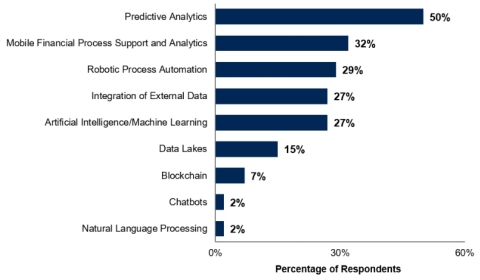ARLINGTON, Va.--(BUSINESS WIRE)--A majority of finance departments expect to deploy one of several top emerging technologies by 2020, according to a worldwide survey of more than 400 organizations by Gartner, Inc.
“More than a quarter of organizations surveyed expect to deploy some form of artificial intelligence (AI) or machine learning in their finance department by 2020,” said Christopher Iervolino, senior director analyst at Gartner. “Moreover, half the respondents expect to deploy predictive analytics in the same period.”
The other technologies organizations expect to deploy in the same time frame are, in ranked order: mobile support for financial processes, robotic process automation (RPA), integration of external data, and AI or machine learning.
Mr. Iervolino explained that CFOs and other finance leaders are looking for new ways to reduce costs, improve controls and uncover fresh insights that could drive competitive advantage. The survey showed the ranking of nine common emerging technologies used to pursue these aims (see Figure 1).
“Alongside this survey data, we’ve also conducted an extensive global analysis of social media conversations around the term ‘financial planning and analysis’ when discussed alongside AI, from 2016 through 2018,” said Mr. Iervolino. “The results show that the number of conversations including this phrase has been growing rapidly, with a compound quarterly growth rate of 15.7 percent.”
Despite rapidly growing interest in AI to improve financial planning and analysis (FP&A), only a few organizations are currently using it successfully, whereas the business case and best practices for other technologies such as predictive analytics and RPA are arguably better understood.
“The lack of working AI deployments is no big surprise, because the technology is not yet built into most FP&A application suites,” said Mr. Iervolino. “There is tremendous potential for transformational improvement, but these capabilities are only just becoming mainstream so the deployment expectations we see in the survey may be unrealistic for many.”
Mr. Iervolino suggested that although most organizations will not be using AI meaningfully in the finance department by 2020, it’s still the right time to assess how the technology could improve FP&A in the future, and to start experimenting. Gartner suggests using the following steps to get started with AI in FP&A.
Step 1: Examine Current FP&A Processes and Tools
Focus on existing shortcomings that could be improved with a more data-intensive approach, using more operational data and more direct participation from lines of business (LOBs). Then prototype proven vendor capabilities against these shortcomings.
Step 2: Expand Existing Financial Analytics Capabilities in FP&A Solutions
Look for underutilized capabilities the organization already has, such as data discovery, forecasting probability, correlation and exception detection functions. If needed, invest in analytics specialists or training to properly prototype these capabilities against known FP&A pain points.
Step 3: Pursue FP&A AI Opportunities
Once the finance organization has properly evaluated its existing tools, and built the expertise to use them, it will be in a strong position to build a business case to invest in an AI initiative, if the potential is identified. Moreover, it may demonstrate the need for the finance department’s involvement in existing AI initiatives.
“There is a tendency within finance organizations to approach FP&A improvements in a tactical way, characterized by a finance-siloed focus on areas such as workflow control, automating business calculations and consistency,” said Mr. Iervolino. “Leaders should consider that a strategic approach to FP&A will provide significantly more value by supporting key partnerships between finance and LOBs, by providing analytics and decision support, and through integrated financial planning and modeling.”
More detailed analysis is available to Gartner clients here: 3 Steps to Determine How Financial Planning and Analysis Could Benefit From AI.
About Gartner for Finance Leaders
Gartner for Finance Leaders supports senior finance executives with their most critical priorities. Gartner offers a unique breadth and depth of content to support clients’ individual success and deliver on key initiatives that cut across finance functions to drive business impact. Learn more at https://www.gartner.com/en/finance/finance-leaders.
About Gartner
Gartner, Inc. (NYSE: IT), is the world’s leading research and advisory company and a member of the S&P 500. We equip business leaders with indispensable insights, advice and tools to achieve their mission-critical priorities today and build the successful organizations of tomorrow.
Our unmatched combination of expert-led, practitioner-sourced and data-driven research steers clients toward the right decisions on the issues that matter most. We are a trusted advisor and objective resource for more than 15,000 organizations in more than 100 countries — across all major functions, in every industry and enterprise size.
To learn more about how we help decision makers fuel the future of business, visit gartner.com.

